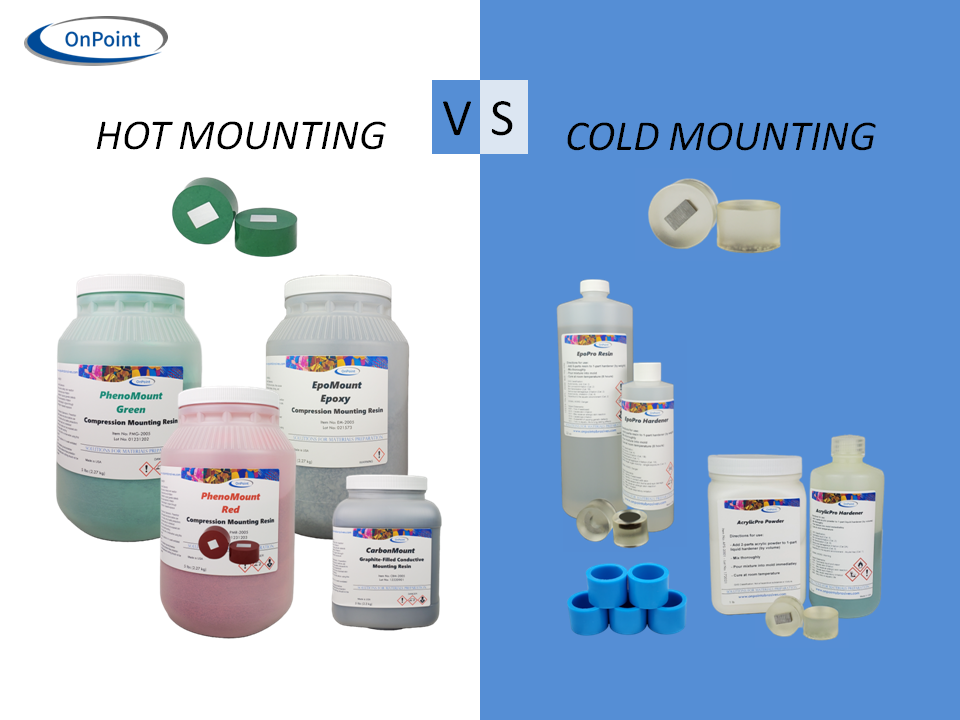
Hot vs. Cold Mounting in Metallography: A Quick Guide
Metallography, the study of the microstructure of metals and alloys, relies heavily on the quality of specimen preparation. One critical step in this process is specimen mounting, and there are two predominant methods: compression or hot mounting and castable or cold mounting. Each method has its own set of advantages and considerations, catering to different needs in metallographic analysis.
Compression or Hot Mounting:

Compression or hot mounting involves encapsulating the metal specimen in a thermosetting resin or thermoplastic, under heat and pressure. Common thermosetting compounds include phenolic, epoxy and diallyl phthalate, with methyl methacrylate being a widely used thermoplastic mounting compound.
Advantages of Compression Mounting:
- Produces harder mounts which improves edge retention on harder materials.
- Produces mounts of predictable size and shape.
- Easy engraving of information on surfaces for identification purposes.
- Simplified manual or hand polishing due to easy specimen handling.
- Convenient use in automated grinding and polishing equipment.
Considerations:
- Requires specialized equipment for heating and pressurizing.
- Mounts are produced one or two at a time.
- Possible injurious effects to specimen from pressure and heat.
Castable or Cold Mounting:
Castable or cold mounting, also known as castable mounting, utilizes liquid mounting media such as epoxies, acrylics, and polyesters to encapsulate the specimen in a mold. This method is often chosen for its simplicity and suitability for samples sensitive to heat and pressure.
Advantages of Castable Mounting:
- No requirement for pressure or external heat in most systems.
- Suitable for heat- or pressure-sensitive specimens.
- Acrylic systems are widely used due to low cost and short curing time.
- Many cold mounts are transparent, making it easy to identify features in the embedded specimen.
Considerations:
- Shrinkage can be an issue with acrylics.
- Require reusable or disposable molds.
- Epoxy systems, though more expensive, offer better edge retention.
Edge Preservation:
Preserving the edges of specimens during mounting is a critical aspect of metallography. Properly mounted specimens, especially in compression mounts, generally yield better edge retention than unmounted specimens. Thermosetting compounds, particularly epoxy with hard filler material, are effective for edge preservation.
Grinding and Polishing:
The choice of mounting method can influence the grinding and polishing steps. Mounted specimens are generally easier to handle and produce flatter surfaces, especially when using automated equipment. The use of proper grinding papers, diamond grinding discs, and polishing materials contributes to achieving optimal results.
Tips for Cold Mounting:
- Clean the specimen thoroughly using acetone or alcohol.
- Use epoxy resins for low shrinkage and excellent adhesion, especially for vacuum impregnation.
- Consider curing times.
- Vacuum impregnation is essential for porous materials, using only low-viscosity epoxy resins.
- Document the process for repeatability specific to your specimen type.
Tips for Hot Mounting:
- Clean the specimen using acetone or alcohol, ensuring it is dry.
- Adjust the specimen size and height according to cylinder specifications.
- Choose the appropriate hot mounting resin based on specimen and process requirements.
- Use specimen clips for small and thin specimens during the hot mounting process.
- Maintain consistent pressure and temperature during curing to avoid porous mounts.

Leave a comment